Even if you are new to SEO, I’m sure you have heard the infamous line, “Content is King.”
However, this is not just any content that we are talking about. Only high-value content that satisfies our target users and the search engine will help you to rank and stay there for a long time. So, what will satisfy the algorithm and our target market?
This is only if our content matches what the people are searching for in a form that they want. To do this, there is no other way but to conduct keyword research.
And I am not going to sugarcoat it:
Keyword research is a tedious process and will take much of your time even before you start content writing. But if done well, it will be the foundation of your numerous high-value content that consistently ranks well.
What is Keyword Research?
The fact that you are reading this means that you already know how vital keyword research is. But it is more than just creating a keyword list related to your products, services, or other topics you want to rank for.
We have to understand that there are different levels of interest and intent each of our keywords has.
Simply put…
Keyword research is a process of analyzing keywords and key phrases our target market actually uses in search engines. This way, we can create effective content strategies that rank well in the search engines to attract and engage new customers.
Why is Keyword Research Important for SEO?
Over the years, Google’s algorithm has constantly changed that it has created undeniable impacts on SEO.
For example:
Stuffing a blog post with the exact match keywords that target customers use in their Google search no longer works. Needless to say, this practice was abused and the quality of the content was sacrificed.
Now that Google gives more importance to user intent and giving value, stuffing content with an exact keyword match no longer works.
This made keyword research for SEO more significant than ever.
Consumers are no longer moved by hard selling. They are embracing the fact that information is at their fingertips which gives them the power to search and compare options. They do not use single keywords. They ask various questions before they decide which product or service to take.
With keyword research, we get to know more about what the users want to know, why they need this information, and how they want these to be accessed.
Add to that, keyword research will help us understand the behavior of our target market, the other relevant keywords they use, their desires, pains, and fears. Yes, it is our modern market research since it points us to which direction our SEO campaigns should take.
How to Do Keyword Research?
There are various ways to do keyword research. The specific process usually depends on your available keyword tools, but let me guide you on how to do proper keyword research that will surely help you no matter what tool you use.
Seed Keywords
The best place to start our keyword research is in the seed keyword list.
Seed keywords define our niche or topic. It is considered as the baseline keyword list that will provide us with the foundation of our expanded keyword research.
How will we identify our seed keywords?
First, start with the terms which are directly associated with your products and services. Whenever I create my seed keywords list, I start with words and phrases directly associated with the brand I am working on.
Let’s say I am creating a list for a women’s shoe store. My list could look like this:
- Women’s shoes
- Ladies shoes
- Heels
- Flat shoes
- Boots
- Trainer shoes
The list could go on even without using a keyword tool just yet. Simply list the terms directly related to your products and services.
Secondly, list the terms used by your target market. After all, it is them who we are writing for and we want to attract, right?
When we speak their language and use their own terms, we become relatable to them. And to find these words, you can search them in blog comments, forums, social media groups, and online communities (Reddit and Quora).
Third, don’t forget to include Google related keywords. To expand my list, I take a look at what Google suggests. You will see the list below the search engine results page (SERP). This cluster of keywords is referred to as “Searches related to [your query].”

Fourth, take a look at the current ranking pages and content. For this, I find that one of the best ways to analyze the keywords is through Google Search Console. GSC provides site owners information about the keywords their pages are ranking for. If you have no access to it, you can use SEMrush.
Lastly, consider the competitor’s keywords. You have not considered it yet but the truth is that your competitors can give you hints which keywords to target. Since both of you have the same target market, understanding how they landed on the first page will help you outrank them.
Free Keyword Research Tools
There are lots of amazing free keyword research tools that can help us get the job done without breaking the bank. If you are just starting out, you can use these:
Google Keywords Planner
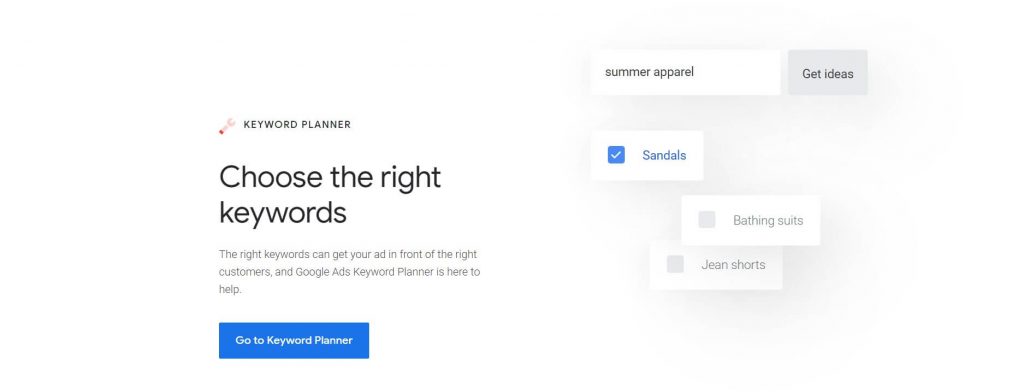
If you don’t know it yet, Keyword Planner is a free Google Ads tool. We can key in any word from the seed keyword list we have created previously. The keyword planner will give tons of keyword suggestions with search volumes.
Ubersuggest.io
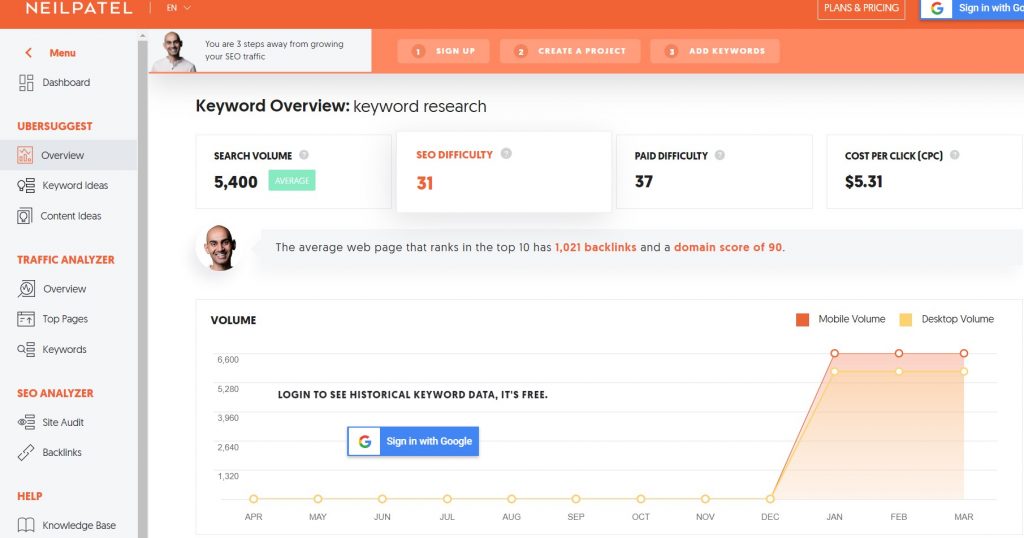
Neil Patel’s Ubersuggest is a free SEO tool that can give you a new list of keyword ideas including long-tail keywords. You can also gain insight into monthly search volume, average CPC, and PPC competition. It is also interesting to note that this tool can also help you with other related search intent such as those in question forms, with prepositions, and comparison phrases.
Answer the Public

This is a goldmine of insights.
Answer The Public is a site that gives autosuggest results provided by Google & Bing. These are the most common questions people usually search in relation to your seed keywords. With these questions, you get to see your target market’s behavior, emotions, pains, and motivations.
Keywordfinder.io
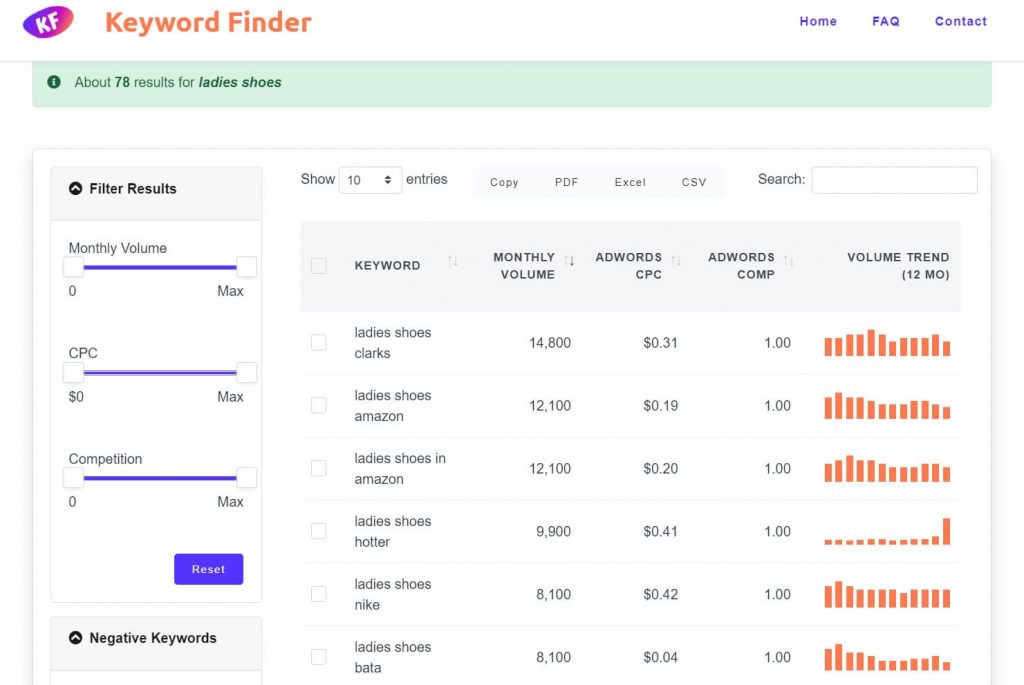
Keyword Finder uses Google’s autocomplete API. You can even type in 10 different seed keywords and get all possible long-tail keywords. While the shallow search only takes a minute and shows 1400 keywords, the deep search can take up to 30 minutes and show you up to 10,000 keywords. But it is important to take note that the total number of searches shown is for the entire world.
Soovle.com

Soovle gives a list of suggested keywords from Google, Yahoo, Wikipedia, Youtube, Bing, and Amazon. One reason Soovle is part of my keyword research is that despite the seemingly outdated design, it is easy to customize search results. It is perfect for those who are new to SEO and feel uneasy with technical graphs.
Metaglossary.com
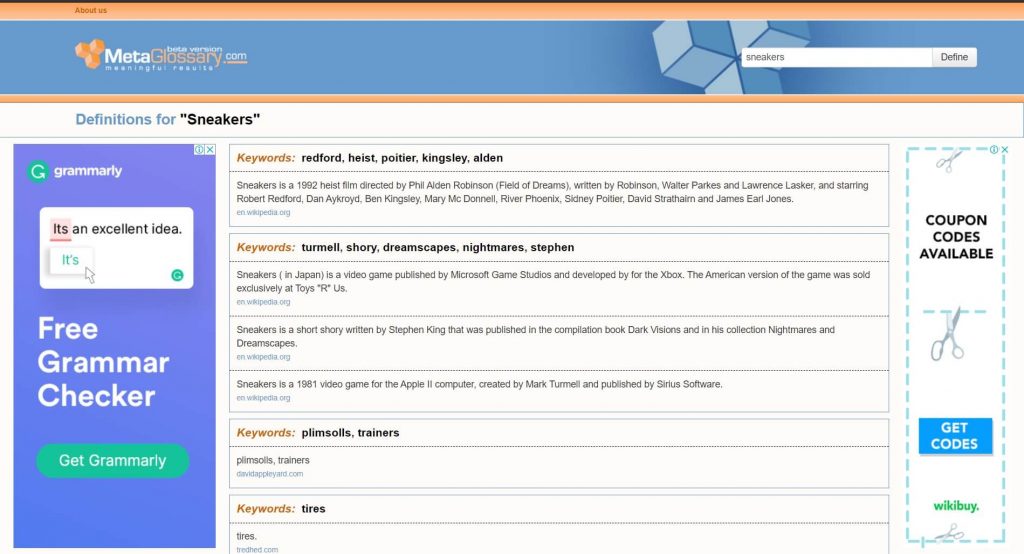
This metasearch tool is simple to use and very straightforward. You can easily search for related keywords and get to know their definitions. It also shows the links of its sources which you can counter check to validate the information it has given.
Keywordtooldominator.com
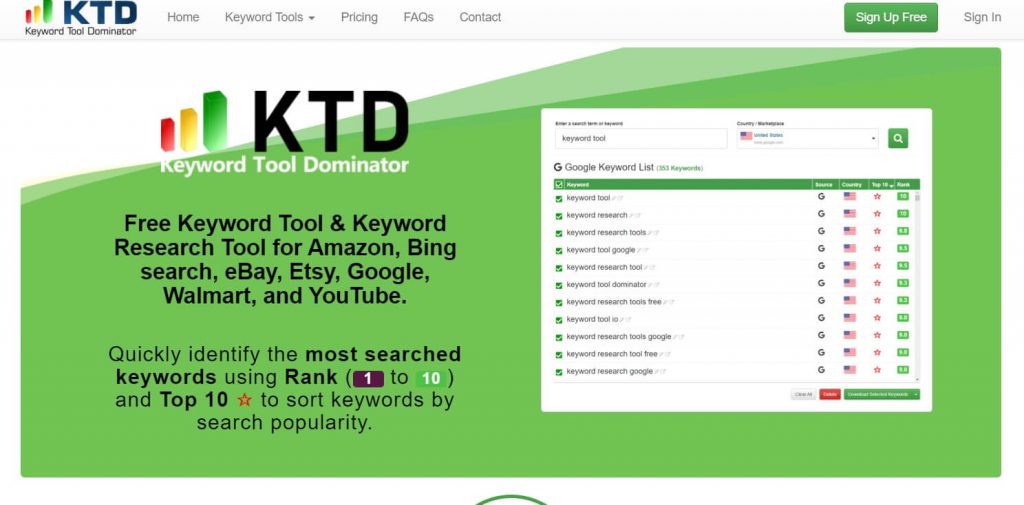
This free keyword tool can help you find keywords that are most likely searched by your target market. It can give hundreds of keywords and the top 10 unique words based on how many times it has appeared on the keywords list.
Entityexplorer.com

This tool may be colorful but it is simplistic. It can help you find seed keywords then branch out towards long-tail keywords. You can even export the image so you can save it to use for your content outline.
Paid Tools Worth Investing In
While there are a handful of free tools that you can use for your keyword research, we still can’t deny that paid tools have so much more to offer.
SEMrush
SEMrush is my one-stop keyword research tool. I have used it for keyword research in various ways. I can create a seed keyword list and find the keywords my competitors have been ranking for. Add to that, I can compare the keywords of various competitors to check which ones they are all wanting to rank for and which keywords have the moderate difficulty that I can easily “snatch” from them.
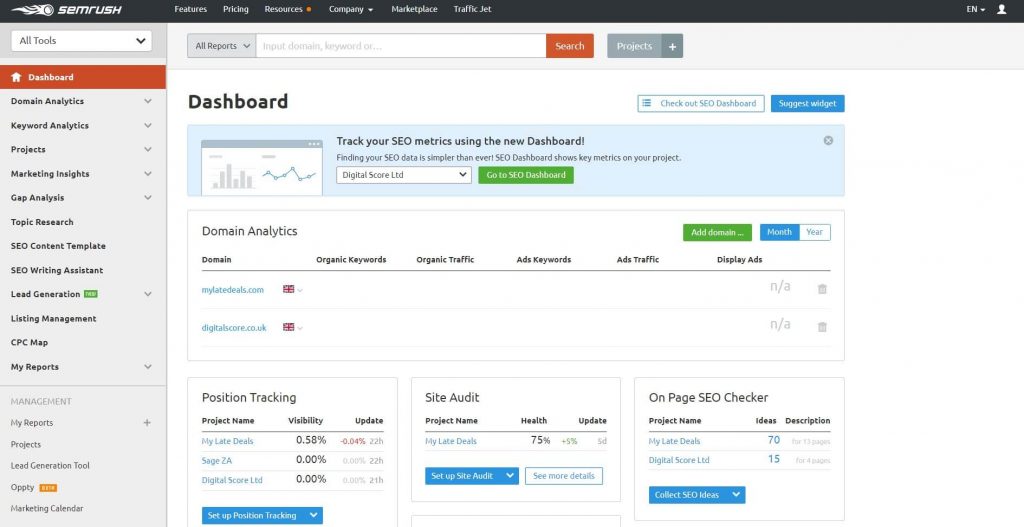
I simply have to type in the URL of a website and SEMrush will give me abundant information such as the website’s keyword traffic volume, keyword difficulty score, and even other potential competitors I haven’t considered yet.
One thing I also look into is the anchor text the competitors have been using for their link building. It has a feature called the keyword magic tool where you can see a list of related keywords that you can categorize as questions, broad match, exact match, and phrase match.
SEMrush has three packages ranging from $99.95 to $399.95. It is an investment that will let you run your SEO, PPC and SMM projects and keep track of your analytics.
Ahrefs
Ahrefs is one of the most popular keyword research tools among SEO experts. This platform can provide a broad keyword report with unique click metrics.
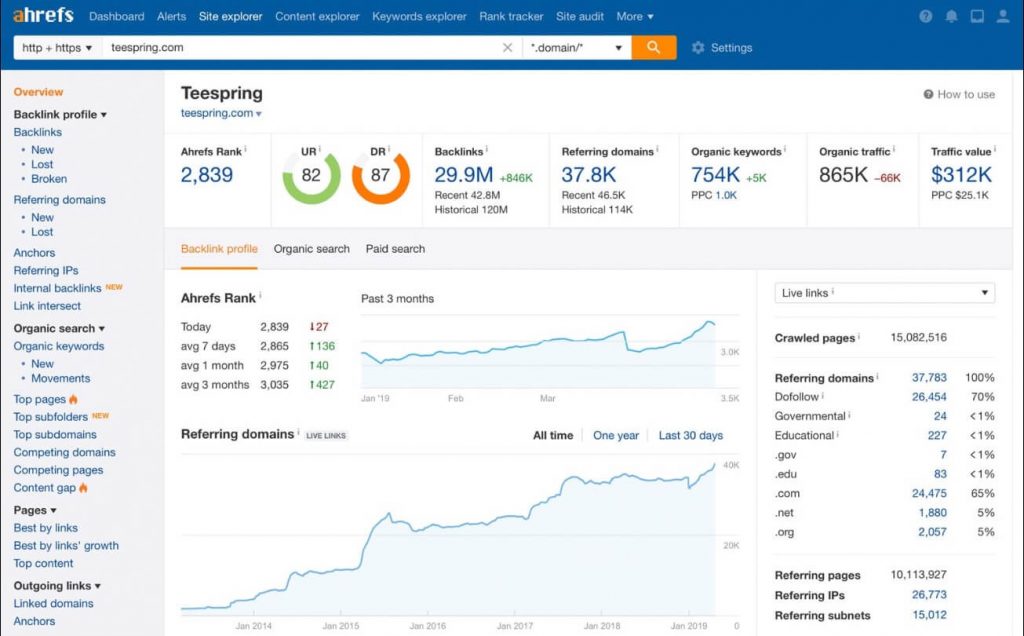
What I like best in this tool is the extensive data it has including the keyword difficulty not to mention its great user interface.
Ahrefs has four packages. The most budget-friendly is the Lite package priced at $99. The biggest package is $999 which lets you and four other users enjoy its features
Choosing the Right SEO Keywords
I won’t be surprised if you get too overwhelmed with listing keywords especially with the tools we have right now. Even the free keyword research tools have a lot to offer despite their limitations compared to paid ones.
Nevertheless, here are the keyword metrics that you need to consider.
Search volume
Search volume simply means the number of times it was used as a query in the search engine. The more people using a certain keyword or keyphrase in Google search, the harder you have to work to rank for it. It is an uphill battle if you are aiming to rank for a keyword with high search volume since usually it is already dominated by huge brands for quite some time.
Typically, since more users are using the keyword, most of your competitors would aim for that to get huge organic traffic. On the other hand, if you target the keywords with too low search volume, only a trickle of traffic will come by the website. It will not be enough to generate big sales.
What I usually do is target highly specific terms with lower competitions. These keywords are called long-tail keywords.
Consider this.
There may be a huge search volume for “computer repair” but there are also users who also search for “local computer repair shops near me” or “Belfast computer repairs”. These longer keywords may have lower search volume, but they have lower difficulty as well.
Clicks
Imagine searching on Google.
You get the top 10 ranking results but of course, you’ll only click on the ones that seemed relevant to your search.
Getting your content in Google SERPs is not enough. You also have to make sure that it gets clicked so the leads would go to the landing page.
When I do keyword research, I also consider the keywords which do not get clicks despite getting a huge number of impressions. It is either telling me to reinforce the content of the page or create a dedicated content targeting that keyword that has a low click-through rate.
Traffic potential
Traffic potential is sometimes confused with search volume.
Search volume is the average number of times people use a given keyword in Google every month. Some tools let you see the monthly search volume of a keyword for free.
Meanwhile, traffic potential will give you an idea of how much traffic rank #1 possibly gets.
Google’s AI has now learned the relationships between words and topics.
Some keywords may not match but they could still have related meaning. If you create a semantically related content, you can rank various keywords in just one page. And each keyword could have its own traffic potential that can contribute to increasing organic leads.
Keyword difficulty
Yes, there are times when ranking for a certain keyword is hard. This makes SEO challenging and fun as well.
Keyword difficulty tells you how difficult it would be to outrank your competitors for that keyword. The higher the keyword difficulty, the harder it is to achieve high ranking.
I use keyword difficulty to gauge how much effort should be given to rank on that keyword. How comprehensive should my content be? How much-related keywords can I use? How long should my content be?
My answers to these will depend on the keyword difficulty.
Cost Per Click (CPC)
You can easily get the keyword’s cost per click from various tools we have discussed above. This metric tells you the average price in US dollars your competitors have been paying on average for every ad triggered by a user click.
I know we are still talking about SEO not Pay Per Click. But the CPC will give you an idea of how much your competitors are willing to pay for that keyword, how relevant the keyword is for your product or service and which keywords are your competitors focusing on.
Refining Your Keyword List
Now that you have a long list of keywords you want to consider in your SEO campaigns, it is time to plan out how you are going to use them.
The best way to do this is to plan an effective customer journey map.
Nowadays, customers interact with brands that are hard to pin down.
The buyer’s journey is not new but it is ever-evolving. So you need to make elaborate keyword research to know which content will fit the customer based on his or her awareness stage.
Let’s say our customer is in the Problem Aware stage, what would his/her query look like?
At this stage, the search terms are often question-based.
Or if the target customer is already at the Solution Aware stage, you will then have to shift your target keywords with descriptive terms like “best data recovery program.”
Your keywords may go to waste if you don’t plan how to use them on your client’s journey
Conclusion
When people talk about SEO, they usually refer to content as its best asset. But without effective keyword research, your SEO efforts will be a hit or miss.
No matter how tedious it is, we must consider keyword research as the foundation of our SEO campaigns.
If you are just starting out, you can use free keyword research tools such as Ubersuggest, Soovle, or Google Keywords Planner. Lack of budget should not stop you from dominating your niche, but take note that these SEO tools have their limitations as well.
You can invest in paid tools and make your keywords research an eye-opening experience. These tools have features that let you create well-guided SEO campaigns.
Finally, what counts the most is your effort to understand the user intent and your customer’s behavior. Keyword research may seem technical but do not get lost along the way. Let us remind ourselves that our goal should be to provide high-quality content to help our users make their best-informed decisions.


